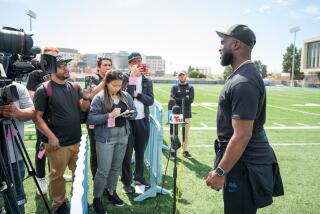Bryan Stow case: Dodger Stadium had ‘culture of apathy,’ MLB says
- Share via
A “culture of apathy and indifference” among game-day staffers at Dodger Stadium was among the problems identified by Major League Baseball in an assessment of the 2011 beating of Giants fan Bryan Stow.
In a motion filed in Los Angeles Superior Court last week, attorneys for Bryan Stow asked to reopen discovery and depose the author of the MLB report, “Dodger Stadium Assessment.”
Attorneys said the report “addresses points which are vital” to their case.
Stow was attacked in the Dodger Stadium parking lot on opening day, March 31, 2011, and suffered brain injuries. Stow, who has been under constant care since the attack, and his family have filed a lawsuit against the Dodgers accusing the team’s management of not adequately protecting fans.
In February, when Marvin Norwood and Louie Sanchez pleaded guilty to the beating, Stow’s attorney Tom Girardi told The Times that the cost of his client’s care had already topped $5 million. He estimated at the time that it would cost an additional $34 million to tend to Stow for the rest of his life.
Girardi maintains that former Dodgers owner Frank McCourt’s insurers, not the current team owners, are liable for any damages.
On Thursday, he stressed that the team’s new ownership, which includes former Laker Magic Johnson, has made “huge” safety improvements and addressed concerns raised in the MLB report.
Girardi’s office said the MLB report was confidential, so attorneys could not produce it. A Dodgers spokeswoman said the team could not release the report or comment on it because it is a subject of pending litigation. A call to Major League Baseball was not immediately returned.
But the motion filed by Stow’s attorneys quotes the assessment in several places and says the report is dated July 29, 2011 -- just months after the attack.
“Following this incident [Stow beating], several Dodger fans contacted Major League Baseball to report a multitude of incidents involving unruly fan behavior that have been occurring at Dodger Stadium in recent years,” the report is quoted as saying.
“Based on these reports and at the direction of Major League Baseball Office of the Commissioner, ‘The Assessment Team’ conducted an appraisal of the Los Angeles Dodgers Baseball Club.”
According to the court documents, the assessment concluded that the “existing and temporary lighting is inadequate,” a fan texting program meant to assist with safety was “ineffective” and the team’s security camera systems failed to “capitalize on current technology.”
The report also appeared to question the team’s decision to transition from using uniformed Los Angeles police officers to using officers in Dodger polo shirts.
“During interviews with staff members the assessment team was told that this transition ‘initiated a deterioration of crowd behavior and an increase of the ongoing security concerns,’” court documents quote the report as saying.
“‘The level of respect and authority that Dodger fans paid to Los Angeles police officers in full uniform did not translate to the sworn officers in Dodger polo shirts … Further, the large pay disparity between uniformed and polo shirt wearing officers has ‘contributed to an adverse work environment among the various security entities deployed at the stadium.’”
Attorneys representing the Dodgers and McCourt did not immediately return a call or email seeking comment.
But in separate court documents, McCourt’s attorneys argued that that security was sufficient at Dodger Stadium the day Stow was attacked.
“The security team deployed at Dodger Stadium on Opening Day 2011 was one of the largest, if not the largest, security presence at a Dodger game in the history of Dodger Stadium,” according a trial brief filed by McCourt attorneys.
“That security team numbered 442, including 195 uniformed on-duty Los Angeles Police Department officers.’’
With more than 55,000 fans in attendance, there was one security guard present for every 124 fans, the trial brief said.
Attorneys also cited several aspects of the team’s “comprehensive security effort” such as security meetings that took place prior to the day of the attack, the LAPD’s “Event Action Plan” and a “Drinking in Public” patrol.
The security ratio on opening day in 2011 “was nearly 10 times greater than the security ratio that the LAPD afforded to the residents of Los Angeles on that same day,” their court documents said.
“Simply put, the Dodgers provided a significantly higher level of security to Stow ... than he would have found anywhere else in the city of Los Angeles.”
The case is scheduled to go to trial May 27.
Twitter: @MattStevensLAT
More to Read
Sign up for Essential California
The most important California stories and recommendations in your inbox every morning.
You may occasionally receive promotional content from the Los Angeles Times.











